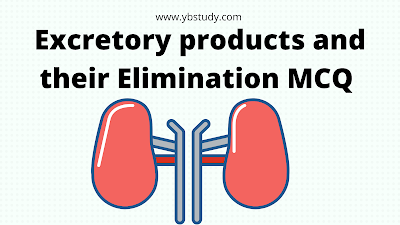Excretory products and their elimination NEET Questions with Answers Pdf
Excretory Products and their Elimination MCQ Questions and Answers PDF
We are providing here important Excretory Products and their Elimination NEET Questions. Students can practice these questions and answers to revise the key concepts. This will help them in obtaining excellent marks in the NEET exam as well as CBSE board exam preparation also.
These Excretory Products and their Elimination MCQ provided here are prepared by Biology subject experts of ybstudy.com and cover all the fundamental concepts involved in Excretory products and their elimination chapter according to the NCERT syllabus. All the MCQ questions are provided with correct answers. These questions bring you the extract of the all information about Excretory products and their elimination MCQ questions based on various definitions, diagrams, formulas, and important facts provided in the chapter.
These MCQ questions may be directly asked in the CBSE board exam or maybe in the NEET exam also, you may have questions based on similar concepts. So, try to practice these Excretory products and their elimination MCQ with Answers thoroughly to fine-tune your preparations and score good marks in the NEET exam.
Excretory Products and their Elimination MCQ for NEET:
1. The kidneys are located_________
(a) Within the coelom
b) Near the buccal cavity
(C) Near the heart
(d) outside the coelom
Answer : d
2. the position of Kidneys is ________
(a) Intraperitoneal
(b) Retroperitoneal
(c) Intraperitoneal
(d) None of these
Answer: b
3. The retroperitoneal kidney is______
(a) Kidney of fish
(b) Kidney covered by peritoneum on the ventral side
(c) Kidney covered by peritoneum on the dorsal side
(d) Kidney uncovered by peritoneum on either side
Answer: b
4. The smallest functional unit of kidney is_____________
(a) Nephron
(b) Collecting tube
(C) Glomerulus
(d) Bowman’s capsule
Answer: a
5. Main function of loop of Henle is__________
(a) Absorption of water
(b) Absorption of sugar
(c) Absorption of sodium
(d) Secretion of tons
Answer: a
6. Renin is released from__________
(a) Juxtaglomerular apparatus
(b) Cortical nephron
(e) Collecting duct
(d) Pelvis
Answer: a
7. Vital morphological and physiological units of the mammalian kidney are___________
(a) Ureters
(b) Seminiferous tubules
(c) Uriniferous tubules
(d) Nephridia
Answer: c
8. Columns of Bertini are found in___________
(a) Testes
(b) Ovaries
(c) Kidney
(d) Liver
Answer: c
9. Ureotelie animals
(a) Lack urease
(b) Do not exerete urea
(c) Cannot form uric acid
(d) Live in water
Answer: a
10. The trigone is_________
(a) A urine-filled cavity within the kidney
(b) A muscular sphincter at the neck of the urinary bladder
(C) A Shmooth connective tissue region in the urinary bladder
(d) A tunic of the ureter
Answer: c
11. The bunch of capillaries present in the Bowman’s capsule is called_________
(a) Pacinian corpuscle
(b) Bowman’s capsule
(c) Malpighian capsule
(d) Glomerulus
Answer : d
12. The number of excretory pores that open outside when the last Proglottid of the tapeworm is separated is/are
(a) Four
(b) Three
(c) two
(d) One
Answer: c
13. which blood vessel takes blood away from the kidney?
(a) Renal portal vein
(b) Afferent arteriole
(c) Renal vein
(d) Efferent arteriole
Answer: c
14. why do we pass more urine during winter and wet seasons?
a) Increased ADH secretion
(b) Increased activity of kidneys
(C) Decreased water absorption by nephrons
(d) Reduced sweating
Answer : d
15. Duct of Bellini is connected with__________
(a) Collecting duct
(b) DCT
(c) Papilla
(d) Ureter
Answer: a
16. Henle’s loop is found in________
(a) Seminiferous tubules of frog
(b) Seminiferous tubules of rabbit
(c) Nephron of mammals
(d) Nephron of frog
Answer: c
17. Duct of Bellini opens on_________
(a) Ureter
(b) Renal papilla
(c) Duodenum
(d) DCT
Answer: b
18. Malpighian tubules remove excretory products from_________
(a) Haemolymph
6) Alimentary canal
(c) Both (a) and (b)
(d) None of these
Answer: a
19. Na+ and Cl are absorbed in the kidney in the region of __________
(a) Ascending limb of Henle’s loop
(b) Descending limb of Henle’s loop
(c) DCT
(d) PCT
Answer: a
20. A fish excretes nitrogen in the form of __________
(a) Ammonium ions
(b) Amino acid
(c) Uric acid
(d) Urea
Answer: a
21. If we remove the pressure receptors from the urinary bladder wall then_________
(a) There will be no micturition
(b) Micturition will continue
(c) There will be no collection of urine in the bladder
(d) Urine will collect in the bladder
Answer : d
22. A man takes a large number of proteins. He is likely to excrete more amount t of__________
(a) Uric acid
(b) Sugar
(c) Amino acids
(d) Urea
Answer : d
23. Volume of urine is regulated by_________
(a) ADH
(b) Aldosterone
(C) ADH and aldosterone
(d) ADH, aldosterone and testosterone
Answer : d
24. Which among the following are uricotelic animals?
(a) Man, monkey, cattle
(b)Sepa, Aplysia, and teleost fishes
(c) Lizards, crows, pigeons
(d) Tadpoles of frogs
Answer: c
25. The main function of the loop of Henle is the reabsorption of water from the contents of renal tubules. In which of the following will the loop of Henle be poorly developed or even absent?
(a) Desert mouse
(b) Carnivorous bird
(c) Freshwater fish
(d)Garden Lizard
Answer: c
26. Presence of blood in urine is known as____________
(a) Albuminuria
(b) Ketonuria
(c) Anuria
(d) Haematuria
Answer : d
27. In the ornithine cycle, the enzyme arginase breaks down arginine into________
(a) Citrulline and urea
(b) Ornithine and ammonia single
(c) Ornithine and urea
(d) Citrulline and ammonia
Answer: c
28. Maximum absorption of water in mammals is in
(a) Lungs
(b) Small intestine
(c) Kidney
(d) Skin
Answer: c
29. Kidneys are not the only organs of excretion. Their work is supplemented by____________
(a) Liver
(b) Heart
(c) Large intestine
(d) Skin
Answer: a
30. The enzyme which converts angiotensinogen to angiotensin I is called__________
(a) Angiotensinase
(b) Rennin
(c) Renin
(d) Rennet
Answer: c

